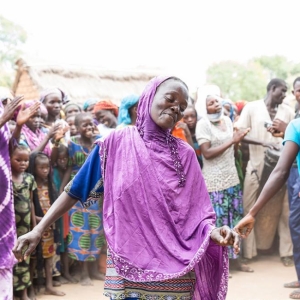En 2015, la Organización Internacional para las Migraciones (OIM) desarrolló un Marco de Gobernanza de la Migración (MiGOF) para ayudar a los Estados a definir los elementos esenciales que constituyen la base necesaria para una “política de migración bien gestionada” a nivel nacional. El MiGOF fue bien recibido por los Estados Miembros de la OIM el mismo año. Los Indicadores de Gobernanza de la Migración (IGM) han sido desarrollados para operacionalizar el MiGOF a través de cerca de noventa indicadores agrupados en seis dimensiones claves de políticas públicas.
Haga clic en la rueda para obtener más información sobre las seis dimensiones de la gobernanza de la migración incluidas en el MiGOF y los IGM.
Los IGM son una herramienta basada en el análisis de las estructuras de la gobernanza migratoria que presenta una serie de pautas sobre los instrumentos que el Estado podría usar para desarrollar su gobernanza. Los IGM evalúan únicamente el marco institucional, jurídico y de políticas públicas en materia de migración, sin entrar a evaluar su implementación en la práctica. Los IGM funcionan como un marco de referencia que permite identificar medidas que los países podrían adoptar para fortalecer sus estructuras de gobernanza de la migración. El objetivo de los IGM es contribuir a la conversación sobre la gobernanza migratoria definiendo lo que podría ser una “política migratoria bien gestionada” en el contexto de la meta 10.7 de los Objetivos de Desarrollo Sostenible (ODS).
Para obtener más información sobre el proceso de los IGM, haga clic aquí
Los indicadores de este dominio analizan los derechos de los migrantes a los servicios sociales básicos, como la salud, la educación y la seguridad social. Estos también presentan los derechos de los migrantes a la reunificación familiar, al trabajo, a la residencia y a la ciudadanía. La ratificación de las principales convenciones internacionales también se incluye dentro de este dominio.
Los indicadores de esta categoría se utilizan para definir la medida en que las personas migrantes tienen acceso a determinados servicios sociales, como la salud, la educación y la seguridad social. También remiten a las medidas adoptadas para garantizar la integración y el acceso al empleo.
Los indicadores en este dominio evalúan los marcos institucionales, legales y regulatorios de los países relacionados con las políticas migratorias. También revisan la existencia de estrategias nacionales de migración que están en línea con el desarrollo, así como la transparencia institucional y la coherencia en relación con la gestión de la migración. Este dominio investiga en qué medida los gobiernos recopilan y usan los datos de migración.
Los indicadores de esta categoría sirven para evaluar los marcos institucionales de autoridades locales o estados en lo referente a la migración. También permiten determinar la existencia de estrategias migratorias que sean acordes a los objetivos de desarrollo, así como la transparencia y coherencia institucional en relación con la gestión de la migración.
Este dominio se enfoca en los esfuerzos de los países para cooperar con otros Estados y con actores no gubernamentales (incluyendo organizaciones de la sociedad civil y el sector privado) en asuntos relacionados con la migración. La cooperación puede conducir a mejoras en la gobernanza al alinear y elevar los estándares, aumentar el diálogo y proporcionar estructuras para superar desafíos.
Los indicadores de esta categoría se centran en las medidas adoptadas por autoridades locales o estados para cooperar con los gobiernos nacionales en torno a cuestiones migratorias, así como con otros agentes no gubernamentales pertinentes, como las organizaciones de la sociedad civil y el sector privado.
Este dominio incluye indicadores sobre las políticas de los países para gestionar el bienestar socioeconómico de los migrantes, a través de aspectos como el reconocimiento de las calificaciones educativas y profesionales de los migrantes, las disposiciones que regulan la migración estudiantil y la existencia de acuerdos laborales bilaterales entre países. Los indicadores se centran igualmente en las políticas y estrategias relacionadas con el compromiso de la diáspora y las remesas de los migrantes.
Los indicadores de esta categoría permiten evaluar las iniciativas de autoridades locales o estados en lo relativo a la movilidad de estudiantes internacionales, el acceso al mercado laboral y las condiciones de trabajo decente para los trabajadores migrantes. Los aspectos relativos a la participación de las diásporas y las remesas de las personas migrantes también pertenecen a esta esfera.
Este dominio estudia el tipo y el nivel de preparación de los países cuando se enfrentan a crisis de dimensiones de movilidad, vinculadas a desastres, el medio ambiente y/o conflicto. Las preguntas se utilizan para identificar los procesos vigentes para nacionales y no nacionales durante y después de un desastre, incluso si la asistencia humanitaria está igualmente disponible para los migrantes que para los ciudadanos.
Los indicadores de esta categoría se refieren al tipo y nivel de preparación de autoridades locales o estados a la hora de encarar los aspectos relativos a la movilidad en situaciones de crisis. Permiten indagar acerca de los procesos establecidos para las personas nacionales y no nacionales tanto durante como después de desastres, incluso cuando la asistencia humanitaria está disponible en la misma medida tanto para las personas migrantes como para las nacionales del país concernido.
Este dominio analiza el enfoque de los países respecto a la gestión migratoria en términos de control fronterizo y políticas de aplicación, criterios de admisión para migrantes, preparación y resiliencia en caso de flujos migratorios significativos e inesperados, así como la lucha contra la trata de personas y el tráfico ilícito de migrantes. También evalúa los esfuerzos y los incentivos para ayudar a integrar a los ciudadanos que regresan.
Los indicadores de esta categoría sirven para evaluar el enfoque que aplican autoridades locales o estados respecto del acceso de las personas migrantes a políticas de seguridad, retorno y reintegración, así como en lo relativo a la lucha contra la trata de personas.
This country Profile describes examples of well-developed areas of the Republic of Burundi governance structures and areas with potential for further development, as evaluated through the six domains of the Migration Governance Indicators (MGI). These address migrants’ rights, a “whole-of-government” approach, partnerships, socioeconomic well-being of migrants, the mobility dimensions of crises, and safe and orderly migration.
Click the icons on the wheel to explore the key findings.
The Migration Governance Indicators (MGI) initiative is a policy-benchmarking programme led by the International Organization for Migration (IOM) and implemented with research and analysis from the Economist Impact. Funding is provided by IOM Member States.
Migration Governance: examples of well-developed areas
- Migrants holding valid work permits in Burundi are entitled to employment and social protection under Decree No. 100/084 concerning the missions, organization, and functioning of the Ministry of National Solidarity, Social Affairs, Human Rights, and Gender.
- Burundi has signed agreements with Rwanda and the Democratic Republic of Congo to ensure the portability of social security rights for migrant workers.
- Refugees, East African Community (EAC) citizens, migrants with specific technical skills, and those born in Burundi have access to employment, provided they hold a valid work permit.
Areas with potential for further development
- Expanding access to government-funded health and education services for all international migrants remains an area for improvement.
- The introduction of postal or electronic voting rights for Burundian nationals abroad could be further strengthened.
- Establishing a national strategy to combat hate crimes, violence, xenophobia, and discrimination against migrants is an area with potential for further development.
Migration Governance: examples of well-developed areas
- The General Directorate of Migration, under the National Police of Burundi, is responsible for designing and coordinating the implementation of migration policy, as mandated by Law No. 1/27 of December 9, 2021.
- Burundi has a dedicated government structure for implementing its emigration and diaspora policies. Under Decree No. 100/053 of September 1, 2020, the Directorate General for Diaspora within the Ministry of Foreign Affairs coordinates the country's engagement efforts with its diaspora.
- A sectoral strategy for the implementation of the 2022-2027 National Diaspora Policy was developed and technically validated in May 2022. The policy aims to "promote diaspora engagement, strengthen, and make their role more visible."
Areas with potential for further development
- Establishing a comprehensive national migration strategy would provide a framework to address migration management, integrating various sectors such as employment, security, and social welfare.
- Implementing formal measures to improve vertical coherence in migration policies is another area that could be strengthened.
- Improving the collection, integration, and publication of migration data across government agencies is an area for development.
Migration Governance: examples of well-developed areas
- Burundi is actively engaged in several regional consultative processes, such as the Regional Ministerial Forum on Migration for the Common Market for Eastern and Southern Africa (COMESA) and the Pan-African Forum on Migration (PAFOM).
- The country has signed formal bilateral labor agreements with key partners, including Saudi Arabia, Qatar, and the Netherlands, which promote ethical recruitment and the portability of social security rights for migrant workers.
- Burundi is part of regional agreements promoting labor mobility, and in 2020, it signed a cooperation agreement with East African and Horn of Africa states to harmonize labor migration policies by creating a common platform for major employers of African migrants.
Areas with potential for further development
- Promoting greater engagement with civil society organizations in agenda-setting and implementing migration-related programs at the local level remains a key area for development.
- Enhancing collaboration within regional consultative processes to further facilitate intraregional mobility and address irregular migration challenges is an area with potential for further development.
Migration Governance: examples of well-developed areas
- The Commission for the Analysis of Work Permit Applications under the Ministry of Public Service, Labor, and Employment considers the skills and qualifications of migrant workers when issuing work permits.
- Burundi grants equal access to higher education for East African Community (EAC) citizens and refugees, provided they meet equivalent admission requirements as in their home countries, in accordance with Law No. 1/05 of October 29, 2020.
- The Government has signed bilateral labor agreements with Saudi Arabia, Qatar, and Gabon, focusing on ethical recruitment.
Areas with potential for further development
- The establishment of national assessments to monitor the demand for migrant workers in Burundi's labor market is an area that could be strengthened.
- Introducing various types of visas to attract specific skills to Burundi is another area that could be improved.
- Developing programs to promote the financial inclusion of migrants and their families, especially those involved in sending or receiving remittances, is another area for improvement in Burundi.
Migration Governance: examples of well-developed areas
- Burundi has a disaster management framework that applies to the entire population, with the Ministry of Interior, Community Development, and Public Security (MIDCSP) responsible for designing and implementing policies related to public security and disaster management.
- Burundi is part of a regional framework that addresses internal and cross-border movements in the context of climate change, environmental degradation, and disasters, and in 2009, it signed the African Union's Kampala Convention for the Protection and Assistance of Internally Displaced Persons.
Areas with potential for further development
- Developing a national disaster risk reduction strategy that includes specific provisions to prevent and address mass displacement is an area that could be strengthened in Burundi.
- Integrating human mobility into national policies on the environment and climate change is another area for improvement.
- Burundi has yet to establish a communication system that allows the public to receive information about evolving crises and communicate their needs to the government.
Migration Governance: examples of well-developed areas
- Burundi has a legal framework and national institutions governing migration, with the Ministry of Interior, Community Development, and Public Security, as established by Decree No. 100/082 of October 12, 2020, responsible for ensuring the country's border security.
- The General Directorate of Migration provides clear information on different types of visas available to migrants, with resources available in both French and English.
- Law No. 1/28 of October 29, 2014, establishes the legal framework for the prevention and prosecution of human trafficking and the protection of trafficking victims in Burundi.
- Border officials receive regular training, on an ad hoc basis, on issues related to irregular migration and human trafficking, promoting safer migration practices at the country’s borders.
Areas with potential for further development
- The establishment of a monitoring system to track visa overstays is an area with potential for further development.
- Establishing concrete procedures to identify and support migrants in vulnerable situations, including providing adequate protection services, constitutes an area for improvement.
2024 octubre




